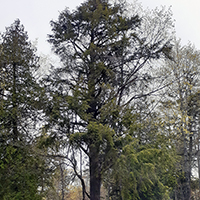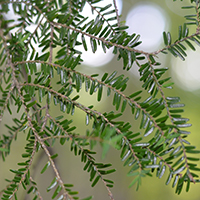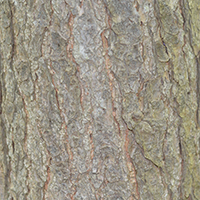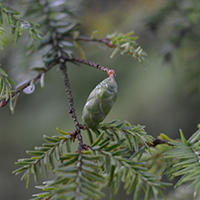What eastern hemlock looks like
Size and shape
- Reaches 30 metres tall.
- Conical tree with a wide trunk tapering into a thin top.
- Branches grow straight out from the trunk and droop at the ends.
Needles
- Shiny green needles with pale underside (1 to 2 centimetres long).
Bark
- Scaly when young and cracks deeply as the tree ages.
Fruit
- Oval-shaped cones (12 to 20 millimetres long).
- Seeds fall from the cones in late fall and winter.
Where eastern hemlock is found
Eastern hemlock grows across Southern Ontario with several smaller populations in Algoma District along the Great Lakes and Northwestern Ontario near the Ontario-Minnesota border.
What you need to know to grow eastern hemlock
- Moisture: grows best on very moist sites.
- Soil: grows well in many soil types.
- Shade: very shade tolerant.
- Caution: eastern hemlock is susceptible to hemlock woolly adelgid , an invasive insect that feeds on nutrients and water from the base of hemlock needles — eventually killing the tree. Hemlock woolly adelgid has been found in several Southern Ontario communities, including Niagara Falls and Hamilton.
Benefits and uses of eastern hemlock
Wildlife benefits
Eastern hemlock is an important tree species for wildlife, offering year-round shelter and habitat for deer, bears and birds. Some mammals browse eastern hemlock stems and needles.
Commercial uses
Eastern hemlock is a popular ornamental tree due to its shade and soil tolerance. Wood from eastern hemlock can be used to make boxes, crates and pulp.
Fun facts about eastern hemlock
- Eastern hemlock is one of several tree species with tannins in their bark. Historically, tannins were used to treat hide and produce leather through a process called vegetable tanning. Today, chrome tanning is more popular.
Updated: January 25, 2024
Published: July 18, 2014



